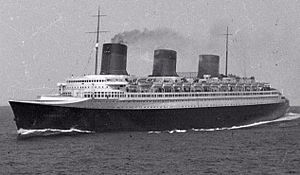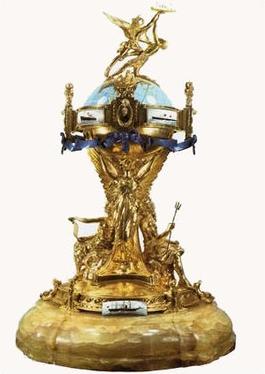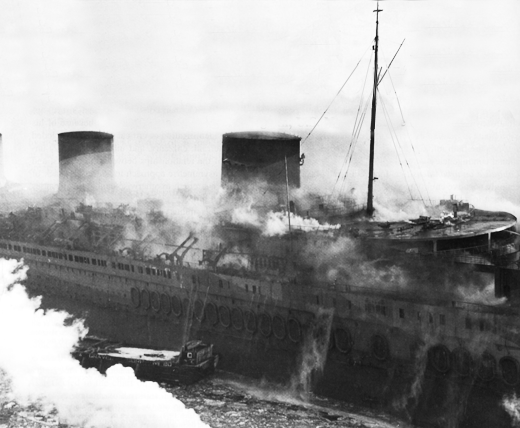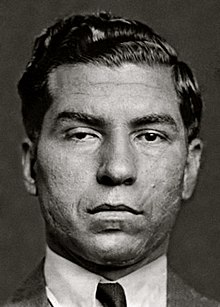
At Sea
The brainchild of Vladimir Yourkevitch, an Imperial Russia ship designer forced to flee to France when the Russian Revolution begins in 1917, featuring Art Deco interiors, a slanting clipper-like bow, a slim hydrodynamic hull and a bulbous forefoot beneath the waterline that reduces drag for increased speed, fuel efficiency, range, and stability, the Compagnie Generale Transatlantique vessel begins growing in the company's shipyard at the Saint-Nazaire harbor on January 26, 1931. Launched on October 29, 1932 in front of 200,000 spectators (not properly planned, the launch wave crashes over hundreds of onlookers, but no one is injured), at completion the SS Normandie has a length of 981.33 feet (or for those in need of an easier visual, almost three football fields), a beam measurement of 117.9 feet, a height of 184 feet, twelve decks, four turbo-electric engines, three propellers (a fourth will be added later), can attain 32.2 knots, can carry 1,972 passengers (848 in first class cabins), and is manned by a crew of 1,345.

Yourkevitch And Normandie Model

Under Construction - 1932
Within, the ship features luxury piled on luxury ... sculptures, wall paintings, apartments featuring dining rooms, baby grand pianos, multiple bedrooms, and private decks, huge winding staircases, elegant entryways, a first class pool featuring a shallow beach area for children, a children's dining room featuring murals of Babar the Elephant, a dining room larger than the Hall of Mirrors at Versailles with twelve pillars of illuminated Lalique glass and two chandeliers that can seat 700 passengers at 157 tables, a cafe grill that can be transformed into a nightclub, a barber shop, exercise areas, indoor and outdoor pools, kennels, a chapel, a theatre that can show movies or host live performances from its stage, a winter garden, air conditioning, and of course, the finest French cuisine.

First Class Dining
Normandie Apartment

Swimming Pool
Cabin Class Theater
Everything comes together to create a traveling palace (among the celebrities that journey aboard the Normandie are Ernest Hemingway, Noel Coward, Irving Berlin, Cary Grant, Walt Disney, Fred Astaire, George Raft, the von Trapp family singers, Marlene Dietrich, Douglas Fairbanks, Jr. and James Stewart), and one that is very speedy. Awarded yearly to the liner that makes the quickest passage across the Atlantic, the French liner will win the Blue Riband award (given off and on since 1823 for both eastern, and westerly travel) on her maiden voyage (taking the crown away from the Italian liner, SS Rex) ... and will battle the RMS Queen Mary for the title through the rest of the 1930s. Everything changes though for the Normandie with the start of WWII, when Germany invades Poland on September 1, 1939.

Maiden Arrival In New York City Harbor

The Blue Riband
Docked in New York when war begins, the United States government interns the ship two days after Germany attacks Poland. Captain Herve Lehuede and his crew are left on board, but they are also monitored by a contingent of the U.S. Coast Guard (for their own protection it is stated). No more France after 1940 (until the war ends in 1945), and Vichy France coming down on the side of the Germans and Japanese, five days after America is attacked at Pearl Harbor, under the right of angary allowing the seizure of a belligerent's assets, the United States takes possession of the liner, with plans to convert the huge vessel into a transport for troops (there had also been discussions about making the vessel into an aircraft carrier) ... a conversion that will see the craft go back to sea as the USS Lafayette (in honor of the French nobleman who helped George Washington win the American Revolution).

Docked At Pier 88 Awaiting Conversion
Tall tales sometimes true, sailors have a superstition that bad things happen when vessels change their names, and the Normandie sadly becomes one of the disasters that gives credence to that fear.

Once Upon A Time!
Deadlines already missed, the conversion is the responsibility of the vessel's prospective next commander, Captain Robert G. Coman, and an engineering force of 458 men ... men that are ordered to hustle, hustle, hustle with WWII in full progress. And so it is that on a cold Monday afternoon (just after 2:30), welder Clement Derrick is working in an area, the first class lounge, where life preservers have been temporarily stored ... life preservers that are filled with highly flammable kapok, stored in highly flammable burlap wrappings. Removing the last of four stanchions in the lounge, a spark from Derrick's torch ignites a bit of burlap, which jumps to a life preserver ... and in seconds, the ship is on fire ... and its carnival time in New York City.

On Fire
Huge plumes of black smoke pushed over Manhattan by a northwest wind, Mayor Fiorello La Guardia cutting short a radio speech to go to the waterfront, Bellevue Hospital sounding its "seven bells" signal that a catastrophe has taken place in the city, and word of mouth quickly alert New York to events unfolding at Pier 88, and soon there are thousands of people taking in the show at the docks, or watching from (at the berths nearby, the Queen Mary and Queen Elizabeth will set up make-shift hospitals to deal with injured workers being carried off the Normandie ... there will be one fatality, Frank Trentacosta, and 285 people injured by smoke, flames, or both) skyscraper windows.
On Fire - White On Water Is Ice
Equipped with the latest in fire fighting equipment, the fire turns into a pyre anyway ... during the conversion, the ship's fire protection system has been turned off, and the Normandie's internal pumping system has been deactivated. Plan A a no-go for putting out the flames, Plan B, for the New York City fire department to quench the fire is also thwarted ... the city's hoses don't fit the ship's French inlets. So Plan C goes into effect, with fire boats rushing to the scene to throw water at the fire ... which results in a new problem ... because of the pier, the fire boats all gather to the open side of the Normandie, causing the water to accumulate within the ship on one side and begin to list (over 6,000 tons of water will be poured on to the ship).
Watering The Flames
In New York City, the ships designer, Yourkevitch rushes to the docks and instantly sees the problem developing and suggests a solution ... open up the Normandie's sea-cocks, let the vessel settle on the Hudson River's bottom, and then pour as much water as is necessary to put out the flames without any worries about the craft capsizing. A good plan if implemented, but not recognizing who Yourkevitch is in the chaos around the ship, the designer is barred from the area by harbor police, and when his idea is later put forth, it is rejected by the commander of the 3rd Naval District that encompasses the harbor, Rear Admiral Admiral Adolphus Andrews. And as predicted by Yourkevitch, the Normandie, nearly crushing a fire boat, capsizes at 2:45 the next morning, coming to rest on her port side at an angle of roughly 80 degrees.
Andrews

Capsized

City Side View
Finger pointing and investigations naturally follow, and though the FBI will recreate the welder's accident several times with exactly the same fire results, rumors and worries persist that foreign saboteurs have caused the tragedy (a shot of the capsized vessel will even be used in the Alfred Hitchcock 1942 thriller, Saboteur) ... a situation which the New York mob will gladly exploit (just the month before in a New York court, 33 German agents had been sentenced to more than 300 years in prison for espionage). Knowing the power that actually controls the waterfront area (it is the kingdom of the Mad Hatter of Murder, Inc., Albert Anastasia), the U.S. Office of Naval Intelligence, using mobsters Meyer Lansky and Frank Costello as a go-betweens, makes a secret deal with Charles "Lucky" Luciano, the most powerful gangster in the city, the man Anastasia reports to ... for a move to a more friendly prison than Sing Sing, and a commutation of his sentence (he has been found guilty of running a prostitution ring), followed by deportation to Italy, the mob will see that no strikes effect the docks during the war ... and that no sabotage is allowed to take place. Deal ... New York City's harbor suffers no strikes or sabotage incidents for the rest of WWII, and reluctantly, New York Governor Thomas Dewey, the man who put Luciano behind bars in the first place when he was a district attorney, commutes the mobster's term on January 3, 1946 ... all compliments of the opening provided by the burning and capsizing of the Normandie.

Luciano

Lansky
Costello

Anastasia
Burnt and capsized, the world's most expensive salvage operation to date takes place in 1943, when the ship is stripped of its superstructure (over 5,000 tons of metal) and finally righted on August 7th of that year (on average, the Navy will have 700 men working on the vessel daily until she is refloated, applying 350 tons of patches and shoring up the craft's decks with a mile and a half of timbers), before being placed in drydock for conversion to an aircraft and transport ferry. Money wasted, the fire and submersion in water for over a year have done too much damage to fix without a massive amount of more money and manpower being applied to the project ... assets unavailable in 1943 with the outcome of WWII still in doubt. Taken off the Naval Vessel Register on October 11, 1945, President Harry S. Truman issues an executive order on September 8, 1946, authorizing the disposal of the liner. Scrap ... the Normandie is sold to Lipsett, Inc. for $161,680, transferred to Port Newark, New Jersey, and begins it goodbye journey to pieces of scrap metal in October of 1946 ... a journey she completes by December 31, 1948 (40,000 tons of steel will be recycled, the last batch turned into paving blocks and sold to a New Jersey contractor for street and home use).

Flying Past The Wreckage

Salvage Operations

Scrap

Normandie Dining Room Door - Now The Entrance To Our Lady Of
Lebanon Maronite Cathedral In Brooklyn, New York
2/9/1942 ... the slow, sad death of one of the most beautiful ships ever built begins when the SS Normandie catches fire in New York City.

SS Normandie
No comments:
Post a Comment